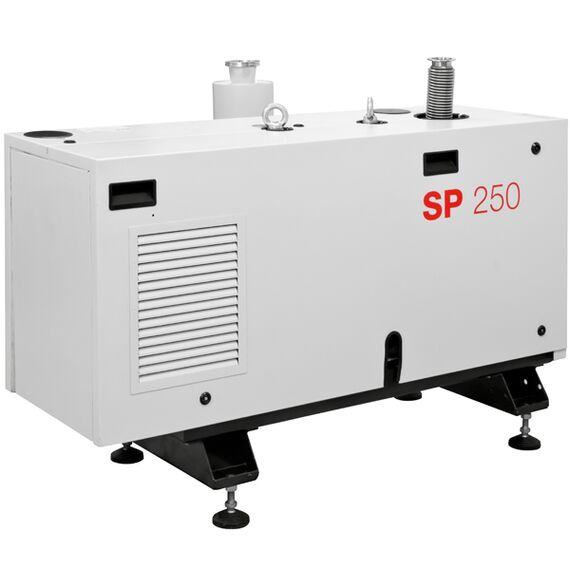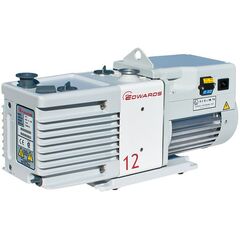Leybold Screwline SP 250 Dry Compressing Screw Vacuum Pump, PN 115-001
- — 12 months warranty
- — SMS notification
- — Return and exchange
- — Different payment methods
- — Best price
These Leybold SP 250 Dry Compressing Screw Vacuum Pump SCREWLINE are from the SCREWLINE SP family were developed in view of the special requirements of industrial applications. The innovative, modular design of the SCREWLINE allows these pumps to be used in all cases where reliable, compact and low maintenance vacuum technology is demanded. SCREWLINE pumps are suited for all applications with higher requirements regarding the backing pump, like for example in processes involving high particle counts or in the hard production area. The dry compressing SCREWLINE pumps are an ideal alternative to conventional oil-sealed vacuum systems.
SCREW ROTORS DESIGN & FUNCTIONThe ScrewLine is a dry compressing screw-type vacuum pump capable of a maximum pumping speed of 250 m3 x h-1. It has been developed specifically for the special requirements of industrial applications. For this reason the ruggedness of the pump was a main design criterion.
Screw Rotors
The screw shaped rotors are fitted to two horizontally arranged shafts and revolve without making contact within the pump chamber. The shafts are synchronized by a toothed gear. The shafts are driven via a further gear stage by an electric motor. In vacuum pumps, the seals and the bearings on the vacuum side are always a potential source for a breakdown. On the one hand lubricants may enter from the bearing into the vacuum process and on the other hand aggressive process media can endanger the bearings.
Cantilevered Bearing
These disadvantages are avoided by the “cantilevered” arrangement of the rotors. The ScrewLine is equipped with two cantilevered screw type rotors which are guided by oversized shafts and bearings. The bearings are both located in the gear chamber of the pump. A further advantage of the cantilevered arrangement is that the pump chamber is easily accessible without having to disassemble any bearings. Thus any possibly required cleaning operations necessary due to the influence of the process can be run easily. The cantilevered rotors minimize the risk of bearing damage and also reduce on-site maintenance to a minimum.
Shaft Seals
Shaft seals are in the case of the ScrewLine pump only required on the delivery side of the rotors. Owing to the small pressure difference between exhaust and gear, simple and reliable seals can be provided. The two shaft seals consist of a combination of a piston ring and a labyrinth seal thus making almost no contact so that the seals will be almost free of wear.
Purge Gas
In standard applications no purge gas will be required at the seals. However, if demanded by the process conditions, a purge gas unit from Leybold Vacuum (P/N 119 031) may be connected.
Cooling
The ScrewLine is air-cooled. A radial fan supports the cooling effect for the casing which is equipped liberally with cooling fins. Depending on requirements, the ScrewLine pumps may be combined with Roots pumps so as to attain higher pumping speeds at lower pressures.
PRINCIPLES OF OPERATIONIn the ScrewLine vacuum pumps the pump chamber is formed by two synchronized displacing rotors and the housing. A pair of tightly intermeshing right-handed and left-handed threads is used to implement with only very few components a large number of stages and thus very low ultimate pressures.
Gas Compression
The screw shaped rotors are fitted to two horizontally arranged shafts and revolve without making contact within the pump chamber. The shafts are synchronized by a toothed gear. The shafts are driven via a further gear stage by an electric motor. In vacuum pumps, the seals and the bearings on the vacuum side are always a potential source for a breakdown. On the one hand lubricants may enter from the bearing into the vacuum process and on the other hand aggressive process media can endanger the bearings.
SLOTSAs in the case of other dry compressing (slot sealed) vacuum pumps, also in the case of screw pumps very tight slots need to be maintained between the components. Otherwise the leaks caused by the pressure drop would have a negative effect on both pumping speed and attainable ultimate pressure. Moreover, the pump might heat itself up too much due to unfavorable thermodynamic processes.
During operation the design of the ScrewLine ensures that the slots are maintained within the operational limits of the pump. In order to limit the temperatures attained by the components, the housing of the pump chamber is air-cooled. Also the rotors themselves are cooled: by oil which is pumped through bores in the rotor shafts and which also lubricates the bearings and the toothed wheels of the pump’s synchronising gear. Thus an uniform temperature spread is attained within the pump.
The amount of “inner compression” has a significant influence on the temperature level within a vacuum pump. In the case of a foreline pump, most of the work on compression is done while the gas is being ejected against the delivery pressure, i.e. in the last stages of the pump. For this reason in the case of the ScrewLine the volume of the gas is already significantly reduced at pressures which are as low as possible so as to minimize this work done on compression. In this way the power requirement of the pump is reduced and less heat needs to be dissipated.
No reviews found















